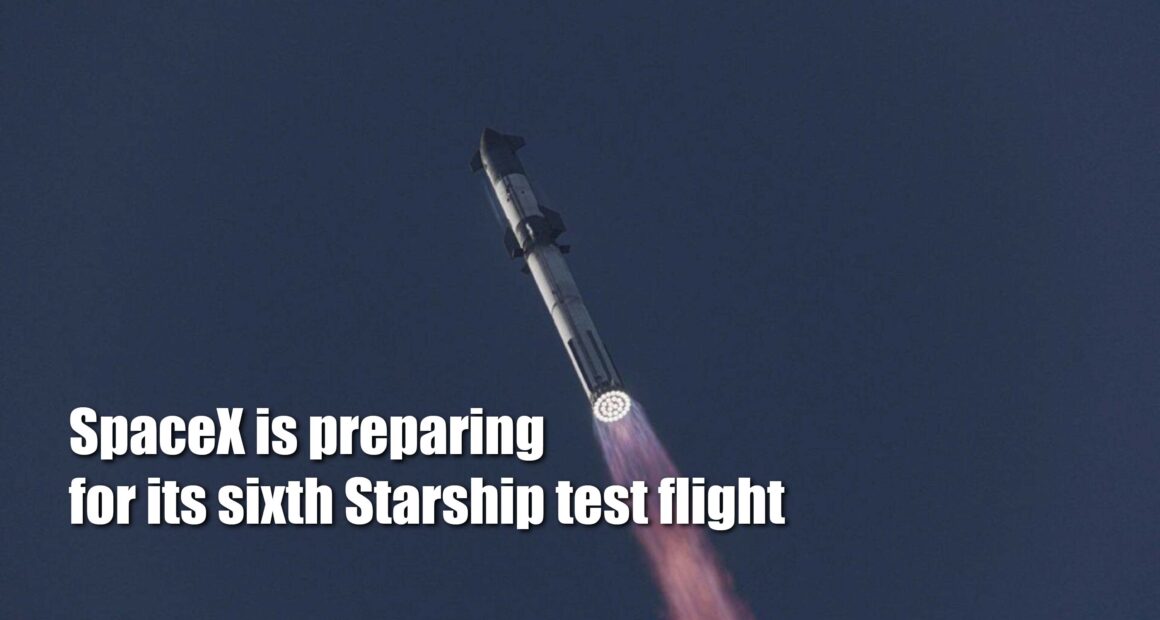As of November 2024, SpaceX is preparing for its sixth Starship test flight, which is scheduled for November 18, 2024. This marks a significant milestone in SpaceX’s ambitious plans to develop and launch the Starship—a fully reusable spacecraft designed to carry humans to the Moon, Mars, and beyond.
Here’s the full information about the upcoming Starship test flight and the broader context of the Starship program:
Background on Starship Program
SpaceX’s Starship is a next-generation, fully reusable spacecraft being developed by SpaceX for a variety of space exploration missions. The Starship system consists of two main components:
- Starship (the spacecraft): A large, next-generation spacecraft designed for long-duration space missions, capable of carrying up to 100 passengers (and potentially more in cargo). It’s designed to be used for missions ranging from lunar exploration to deep-space travel, including crewed missions to Mars.
- Super Heavy Booster (the first stage): A massive booster rocket designed to lift the Starship into space. The Super Heavy booster will be powered by a number of Raptor engines, the same engines used in Starship itself, making the entire system reusable.
Previous Test Flights
Before this sixth flight, SpaceX had already conducted several test launches of the Starship system. The test flights are a crucial part of SpaceX’s iterative development process, where each flight aims to test the spacecraft’s capabilities, safety, and performance under various conditions. These flights have seen a range of successes and failures, which SpaceX has used to refine and improve the design of both the Starship spacecraft and the Super Heavy booster.
Details of the Sixth Test Flight (November 18, 2024)
The upcoming test flight on November 18 is expected to push the Starship program further toward its goals of achieving full orbital capability and eventual crewed missions. Here’s what’s likely to be involved:
- Launch Vehicle:
- The flight will involve the Starship system, including the Super Heavy booster and the Starship spacecraft.
- SpaceX plans to launch from its Boca Chica facility in Brownsville, Texas, where the company has been developing and testing the Starship system.
- Objective of the Flight:
- The primary objective is likely to be a test of the full orbital launch system, which includes testing the integration between the Super Heavy booster and the Starship spacecraft. This could include testing the booster’s power, the spacecraft’s aerodynamic stability, and performance in space.
- While previous tests have involved either suborbital flights or the spacecraft launching without the Super Heavy booster, the goal is to perform a full orbital launch, where Starship and its booster are tested together in a true mission profile.
- SpaceX’s goal is to demonstrate that the system can safely and reliably launch, reach orbit, and return to Earth for reusability. They have been working on perfecting the booster’s re-entry and landingcapabilities as part of the testing.
- Launch Sequence and Timeline:
- The launch will be part of SpaceX’s broader effort to demonstrate full reusability of the Starship system, which could drastically reduce the cost of space access.
- It is expected that the test flight will include the booster’s return to Earth for a controlled landing, similar to the process SpaceX uses with its Falcon 9 rockets, though the Super Heavy booster is much larger and more powerful than the Falcon 9.
- The Starship spacecraft itself might also undergo a series of maneuvers, such as orbital insertion, atmospheric re-entry, and landing (either in the ocean or on land, depending on the flight objectives).
- Challenges and Risk Factors:
- As with previous test flights, this flight carries risks, especially because Starship has not yet achieved a fully successful orbital launch. Even SpaceX’s advanced engineering approach acknowledges that failure is often part of the development process.
- Some of the risks include failure of the Super Heavy booster’s engines, issues with the Starship’s heat shield during re-entry, or potential separation failure between the booster and spacecraft.
- However, SpaceX has shown great resilience in addressing these challenges quickly, using failure data to improve the design of the spacecraft and the launch system for the next test.
- Expected Outcomes:
- If successful, this flight will demonstrate that the Starship system is ready for orbital missions, laying the foundation for future uncrewed cargo flights, crewed space missions, and potentially deep space exploration.
- A successful test could also bring SpaceX closer to achieving one of its most ambitious goals: reducing the cost of space travel through reusability, making it possible to send large payloads and crew into space much more affordably than with traditional expendable rockets.
Starship’s Future Goals
SpaceX’s ultimate aim with the Starship system is to revolutionize space travel. The system is designed to be:
- Fully reusable: Both the Starship spacecraft and the Super Heavy booster are intended to be reused multiple times, which would drastically reduce the cost of launching payloads into space.
- Deep-space capable: Starship is being developed with long-duration missions in mind, such as sending humans to the Moon under NASA’s Artemis program, sending crewed missions to Mars, and even enabling space tourism and private space travel.
- Lunar and Mars missions: The spacecraft is being tailored for use in NASA’s Artemis program, which plans to return humans to the Moon, and could eventually carry astronauts to Mars in the 2030s.
Significance of This Test Flight
- SpaceX’s Vision for the Future: Each Starship test flight is an important step in demonstrating the future of space travel. SpaceX’s ultimate vision is to create a multi-planetary future for humanity, with Starship playing a key role in that effort.
- Competition and Industry Impact: If SpaceX successfully demonstrates Starship’s orbital capability, it will place the company in a leadership position in the space industry, with the potential to dominate the commercial spaceflight sector for decades to come. SpaceX’s rapid development cycle and its focus on reusability could challenge other space agencies and private companies like Blue Origin and Boeing.
SpaceX is preparing for its sixth Starship test flight on November 18, 2024, with the goal of further refining the Starship system’s performance and capabilities. This flight is a key step toward achieving full orbital launches and moving closer to SpaceX’s long-term vision of reusable spacecraft, enabling space tourism, crewed missions to the Moon and Mars, and transforming the future of space exploration. Despite the inherent risks involved, the success of this mission could be a game-changer in the space industry, showcasing the potential for a new era of affordable and sustainable space travel.









